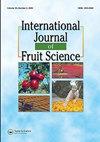Physicochemical and Processing Qualities of Guava Varieties in Kenya
IF 2.4
3区 农林科学
Q2 HORTICULTURE
引用次数: 6
Abstract
ABSTRACT Despite Kenya’s favorable climate for both exotic and indigenous commercial guava production, neglect has limited research on the fruits’ physicochemical and processing qualities. The white-fleshed, red/pink-fleshed guava, and, to a lesser extent, strawberry guavas that grow in different agroecological zones are the most common Kenyan varieties. The purpose of this study was to determine the physicochemical properties and processing qualities of the common Kenyan guava fruits. A completely randomized study design was used to profile the fruits' physicochemical composition and processing qualities. Approximately 1000kg of the red and white-fleshed guava fruits and 150 kg of strawberry guavas were procured in duplicates from randomly selected trees in farms within Taita Taveta and Kitui counties. These were pooled into respective varieties and subjected to triplicate batches for the analysis of physicochemical and processing qualities. The fruits had distinct flesh colors and sizes that varied significantly (p<0.05), with shapes ranging from oval to round to pear-shaped. The chemical composition of the fruits varied significantly (p<0.05), with a PCA biplot explaining approximately 58% of the variability due to intra (61%) and inter (39%) varietal differences. The strawberry guava’s vitamin C levels were significantly (p=0.0001) lower than the red and white guavas’, at 164.11±11.85, 1365.15± 50.56 and 1665.56±126.50 mg100−1g, respectively. The white-fleshed guavas, on the other hand, were low in β-carotenes (0.04±0.06 mg100−1g) in comparison to the red-fleshed (1.98±0.62mg100−1g) and strawberry guava (1.55 ± 0.30mg100−1g). The strawberry guavas had significantly (p<0.05) higher mineral and total flavonoids contents whereas the total phenolics (1649.14±329.70mgGAE100−1g) and antioxidant activities (1989.14±383.47µMTE100−1g) were significantly (p=0.048) higher in the red-fleshed guava. While strawberry production would be a processing constraint, the red-fleshed guavas had significantly (p<0.05) higher beta-carotene, phytochemicals, and minerals than the white, and therefore best suited for processing.肯尼亚番石榴品种的理化和加工品质
尽管肯尼亚的气候有利于外来和本土番石榴的商业生产,但对番石榴果实的理化和加工品质的研究却受到了忽视。生长在不同农业生态区的白色番石榴、红色/粉红色番石榴,以及较小程度上的草莓番石榴是肯尼亚最常见的品种。本研究的目的是确定肯尼亚常见番石榴果实的理化性质和加工品质。采用完全随机的研究设计来分析水果的理化成分和加工品质。在Taita Taveta和Kitui县的农场中随机选择的树木上,重复采购了大约1000公斤红色和白色果肉番石榴果实和150公斤草莓番石榴。这些被集中到各自的品种中,进行三次批次的理化和加工质量分析。果肉颜色和大小差异显著(p<0.05),形状从椭圆形到圆形再到梨形。果实的化学成分差异显著(p<0.05), PCA双图解释了品种内(61%)和品种间(39%)差异造成的约58%的变异。草莓番石榴的维生素C含量分别为164.11±11.85、1365.15±50.56和1665.56±126.50 mg100−1g,显著低于红色和白色番石榴(p=0.0001)。另一方面,白肉番石榴的β-胡萝卜素含量(0.04±0.06 mg100−1g)低于红肉番石榴(1.98±0.62mg100−1g)和草莓番石榴(1.55±0.30mg100−1g)。草莓番石榴的矿物质和总黄酮含量显著(p<0.05)高于红肉番石榴,总酚类物质(1649.14±329.70µMTE100−1g)和抗氧化活性(1989.14±383.47µMTE100−1g)显著高于红肉番石榴(p=0.048)。虽然草莓的生产会对加工产生限制,但红瓤番石榴的β -胡萝卜素、植物化学物质和矿物质含量明显高于白瓤番石榴(p<0.05),因此最适合加工。
本文章由计算机程序翻译,如有差异,请以英文原文为准。
求助全文
约1分钟内获得全文
求助全文
来源期刊

International Journal of Fruit Science
Agricultural and Biological Sciences-Agronomy and Crop Science
CiteScore
6.40
自引率
0.00%
发文量
64
审稿时长
10 weeks
期刊介绍:
The International Journal of Fruit Science disseminates results of current research that are immediately applicable to the grower, extension agent, and educator in a useful, legitimate, and scientific format. The focus of the journal is on new technologies and innovative approaches to the management and marketing of all types of fruits. It provides practical and fundamental information necessary for the superior growth and quality of fruit crops.
This journal examines fruit growing from a wide range of aspects, including:
-genetics and breeding
-pruning and training
-entomology, plant pathology, and weed science
-physiology and cultural practices
-marketing and economics
-fruit production, harvesting, and postharvest
 求助内容:
求助内容: 应助结果提醒方式:
应助结果提醒方式:


